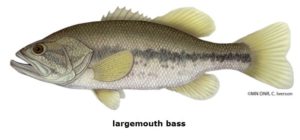Fish species found in our lakes
Anglers agree that the fishing is great in the Three Lakes. But to many of us, the fish in our lakes are a mystery. So we’ve asked our renowned fishermen to help us learn more about the fish in our lakes.
Cold water fish
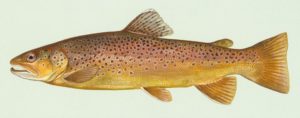 Fish tend to either live in cool to cold water, or warmer waters. Brown and brook trout, like all salmonoids, prefer cold water, and don’t grow much or reproduce in warm waters. Our lakes have a warm upper layer each summer, and the cold dark waters below the thermocline often don’t have enough oxygen for the fish to thrive. We continue to stock brown trout, but some brook trout are thought to spawn in the cool tributary stream to Lake Oscaleta.
Fish tend to either live in cool to cold water, or warmer waters. Brown and brook trout, like all salmonoids, prefer cold water, and don’t grow much or reproduce in warm waters. Our lakes have a warm upper layer each summer, and the cold dark waters below the thermocline often don’t have enough oxygen for the fish to thrive. We continue to stock brown trout, but some brook trout are thought to spawn in the cool tributary stream to Lake Oscaleta.
Warm water fish – piscivores
The rest of the fish in our lakes are part of a warm water fishery. The top level of fish are game fish, the piscivores. The largemouth bass and smallmouth bass are favorite fishing targets, and at least one fisherman brags of catching and releasing 100 bass in a single day’s fishing. But, you know, fish stories. Largemouth bass have mouths which extend beyond their eyes. They tend to prefer to hide among the weeds or deep water, and come into the shallows in morning and evening. Smallmouth bass tend to like rocky areas with 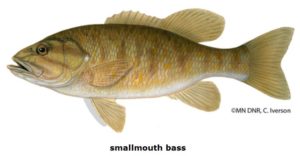 larger gravel and are not as tolerant of very warm temperatures as largemouth. Smallmouth are said to be very strong fish for their weight. Anglers swear they have hooked a fish twice as large until the 2-pounder is in the net.
larger gravel and are not as tolerant of very warm temperatures as largemouth. Smallmouth are said to be very strong fish for their weight. Anglers swear they have hooked a fish twice as large until the 2-pounder is in the net.
Bass spawn in the spring, when the water temperature ranges from the high 60s into the 70s. The male fans out a nest in sand or mud (largemouth) or coarse sand and gravel (smallmouth and rock bass) and guards the eggs and fry. If you see a nest in 2 feet of water or more, it’s probably a bass. Nests in shallow water are most likely sunnies.
The yellow perch has a yellow body and five to nine olive-green distinct vertical bars on each side. White perch are silvery-gray in color, with a light belly. NYS DEC considers white perch an invasive species and they have become a nuisance in some lakes where they have been introduced because they compete with and eat native fish and fish eggs.
Eastern chain pickerel is an energetic fighter when hooked, making it popular with anglers. Chain pickerel ambush large fish from cover with a rapid lunge and to secure it with its sharp teeth. Chain pickerel are also known to eat frogs, worms, mice, and crayfish.
Black Crappie like clear lakes with abundant vegetation and sand or mud bottoms. Crappie will eat small minnows, insects, and crustaceans. They are popular fishing targets as they are considered easy to catch during their evening feeding.
Warm water fish – planktivores
The next category of fish are largely planktivores, eating the plants and animals that float in the water column. Algae are the base of the food web in our lakes, and the very small particles of algae are eaten by a variety of zooplankton. Some fish eat algae and zooplankton as well as invertebrates – and of course worms. Sunfish are in this category of fish that live in fairly shallow waters, seek abundant weedy cover, make nests in shallow water, and feed all day. The Three Lakes have pumpkinseed sunfish, bluegills, redbreast sunfish, and perhaps the rare longeared sunfish. Also in this category are minnows like golden shiners and banded killifish, which are favorite prey of the bass.
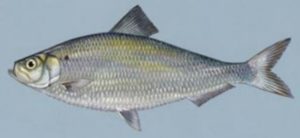 Alewives are another planktivore that provide food for larger game fish. Alewives are silver in color with a blue-green metallic luster along the back, usually with a black spot behind the gill cover. These fish usually live in salt water and enter freshwater to spawn but have become established in landlocked lakes by bait releases or as forage fish. Alewives move in large schools which are sometimes visible in the open water in our lakes. NYS DEC considers alewives to be invasive and they have changed ecosystems by outcompeting native fish and by being voracious feeders on zooplankton, which in turn allows more algae to thrive.
Alewives are another planktivore that provide food for larger game fish. Alewives are silver in color with a blue-green metallic luster along the back, usually with a black spot behind the gill cover. These fish usually live in salt water and enter freshwater to spawn but have become established in landlocked lakes by bait releases or as forage fish. Alewives move in large schools which are sometimes visible in the open water in our lakes. NYS DEC considers alewives to be invasive and they have changed ecosystems by outcompeting native fish and by being voracious feeders on zooplankton, which in turn allows more algae to thrive.
Warm water fish – detrivores
Other fish are largely detrivores, eating debris and invertebrates that live in the sediment. These fish have mouths towards the bottom of their bodies, and some have whiskers that help them find food. Bottom feeders in the three lakes include white suckers, common carp, black bullheads and brown bullheads. The bullheads are a variety of catfish and prefer to feed at night.
A few other unique inhabitants are in our waters. The American eel can be found in our lakes, although it must return to salt water to spawn. We also have some freshwater jellyfish.
We also have hybrid bass, although maybe only a few are left. These were introduced about 1991 thinking they were white perch. Reportedly an unauthorized stocking of 400 white perch from Peach Lake occurred in the spring of 2018.
History and fishing records
A historical record black bullhead of 8 pounds was taken from Waccabuc in 1951.
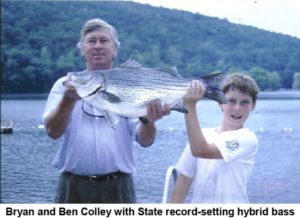 George Harris caught the NYS record hybrid bass in Waccabuc on August 8, 2000 while fishing for trout and it weighted 11lb 2 oz. Then on July 30, 2004, Brian Colley fishing Waccabuc broke George’s record with a 15lb 5oz hybrid bass in front of the Waccabuc Country Club.
George Harris caught the NYS record hybrid bass in Waccabuc on August 8, 2000 while fishing for trout and it weighted 11lb 2 oz. Then on July 30, 2004, Brian Colley fishing Waccabuc broke George’s record with a 15lb 5oz hybrid bass in front of the Waccabuc Country Club.
Joe Tansey caught a 3lb 1oz white perch in Oscaleta on September 21, 1991. This is still the NYS record and a world record for 6 pound test line. World records go by line strength.
The largest brown trout reported in our lakes was a 12 pound brown trout taken in Oscaleta around 2010.
Joe Tansey also caught an eel in Oscaleta that might have been a record. He never weighed it but it was 50 inches, which would make it about 8 pounds or more.
See the food web page for more information on fish guilds. And see the fishing page for more information on fishing guidelines and stocking.
Thanks to Joe Tansey for providing information for this page.
